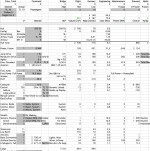Let's talk RULES AS WRITTEN and quote an actual RULE that was actually WRITTEN and is actually about STARSHIP MOVEMENT from the surface to the orbit.
If my fellow gentle-readers will turn your attention to LBB2:81, page 4 you will read the following:
"Travellers travel. They move between worlds as well as on their surfaces. The distances such travel covers may be interplanetary or interstellar in scale. Interplanetary Travel: Worlds orbiting the same star are accessible by interplanetary travel, on ships operated by local entrepreneurs, or with a variety of small craft. But, interplanetary travel takes long periods of time; since most stellar systems have only one major world, interplanetary travel is infrequent. lnterplanetary travel takes time. The travel formulae and diagram on page 10 show a typical interplanetary journey, and equations which can determine time required (if distance and acceleration are known), acceleration required (if distance and time are known), and distance travelled (if time and acceleration are known). All of the formulae use the MKS (meters, kilograms, seconds) unit system, and assume that the ship is undertaking a journey from rest, that it accelerates continuously to midpoint of the trip, and then decelerates to rest again. In addition, several travel times and travel distances have been calculated out for ready reference."
There can be no question that this discusses travel by spaceship and discusses movement in "They move between worlds as well as on their surfaces" with a reference to a formula on "page 10" and "several travel times and travel distances have been calculated out for ready reference." Traveller players are very familiar with the formula on Page 10:
Time = 2 x sqrt (Distance / acceleration)
"The three travel formulae assume constant acceleration to midpoint, turnaround, and constant deceleration to arrive at the 'destination at rest, as shown in the diagram above. There are three variables; if any two are known, the third can be determined using one of the formulae above."
"Below are listed a number of typical travel times for various distances and accelerations. Times are in the most convenient unit: s=seconds, m=minutes, h-hours, and d=days."
Within the chart, please note the first two entries under 1G: 1000 km at 1G = 633 seconds and 10,000 km at 1G = 2000 seconds.
Indulge me one final piece of text before I make my point and cast your eyes upon LBB2:81 page 11 and note the heading "
Typical Distances" and the value of 10,000 km for "
World Surface to Orbit". From this one MUST conclude that the values in the table for 1000 km and 10,000 km are intended for "surface to orbit" trips rather than some unimaginably short burn-turn-decel trip between a world and moon orbiting at a mere 1000 km. Thus the actual RAW for ship flight to orbit make no allowance for local gravity being subtracted from the performance of the MD. Just the opposite, they explicitly indicate that a trip to orbit in a 1G ship employs a full 1G irrespective of the size of the world. NO WORLD would have ZERO GRAVITY, so no 1G drive would get 1G performance from surface to orbit.
The MD generates 1G of thrust irrespective of local gravity. On a 7G planet, the MD would accelerate the craft at 1G. On a 0.1G planet, the MD would accelerate the ship at 1G. It is NON-NEWTONIAN physics.
The rules on SPACE MOVEMENT inform us that the vector for local gravity will bend the trajectory of a ship's path, but the rules on TRANSPORTATION just as clearly indicate that local gravity is not subtracted from MD performance from surface to orbit.
For STRIKER MINIATURES COMBAT, Striker rules take precedence and the 1G ship may not participate. For COMBAT MOVEMENT, the planetary gravity bands alter the ship's vector.
For SURFACE TO ORBIT, LBB2:81 pages 10-11 tells you it takes 2000 seconds or use the equations to calculate it for yourself. Those are the Rules as Written for a ship to fly to orbit.

